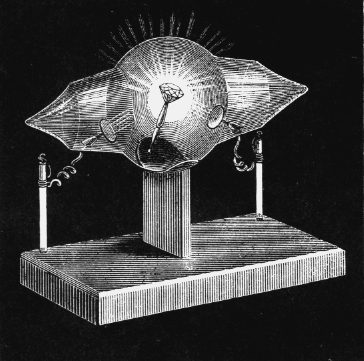In the area of biological effects and medical applications of [low level] radiation approximately 25,000 articles have been published over the past 30 years. Despite the feeling of some people that more research needs to be done, scientific knowledge in this area is now more extensive than for most chemicals. Based on a recent in-depth review of the scientific literature, the WHO concluded that current evidence does not confirm the existence of any health consequences from exposure to low level electromagnetic fields.
Studies by the European Commission’s Scientific Committee on Emerging and Newly Identified Health Risks and by the International Commission on Non-Ionizing Radiation Protection (both also disregarded by Mr. Ketcham) reached similar verdicts, as did a paper published last month in the Journal of the National Cancer Institute and summarized in Scientific American.

19th Century Cathode Ray Tube. (Invented by William Crookes, 1879)
These and other reports recognize that cell phones have not been in existence long enough to rule out the possibility of long-term effects and that more research on cell phone use by children may be called for — a rather tepid conclusion compared with what an innocent reader would take away from Mr. Ketcham’s skewed reporting. His article goes on to conflate cell phones with wifi — both transmit on about the same frequencies — even though there is a world of difference between holding a transmitter against your head and sitting across a room from one.
Most people turn to GQ for fashion advice not to deepen their understanding of complex issues. But when science is not on your side you take what you can get. On the front page of this morning’s New Mexican is a picture of William Bruno, a Los Alamos researcher and anti-wireless activist, holding up a copy of the Ketcham article at last night’s City Council meeting. Mr. Bruno, along with Arthur Firstenberg (the man who is suing his Santa Fe neighbor for using a cell phone) led the unsuccessful attempt to ban wifi from the public library and City Hall. Now they are opposing the approval of an updated telecommunication ordinance (the old one was overturned in federal court) and the approval of franchises by two companies that want to expand Santa Fe’s access to the infosphere — one with highspeed fiber optic cables and another with a distributed network of small wireless antennas. At one point, the New Mexican reports, Mr. Bruno became so upset that the police were called.
The Council tabled the measures and went on to pass a resolution calling for, among other things, the Federal Communications Commission to reassess the health effects of electromagnetic waves. Maybe the purpose was to get the hecklers out of the room, but the overall effect was to lend support to pseudoscience.
Also on the front page of today’s New Mexican is a story about a new venture by Google, which is enlisting municipalities to install and test ultra highspeed broadband — 100 to 1,000 times faster than what most of us have today. Santa Fe should be pushing to be first in line instead of wasting time trying to mollify a tiny number of people who blame their troubles on invisible rays.
George Johnson
The Santa Fe Review

Related posts:
Electromania, Part 2
Electromania, Part 3
What Science Really Knows About Wifi
Wi Fi Fo Fum
M.E.S.S. (Multiple Everything Sensitivity Syndrome)